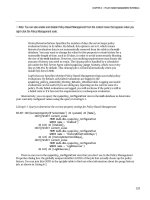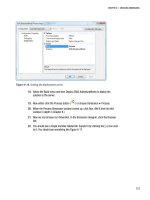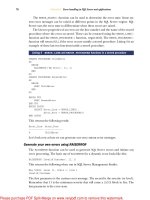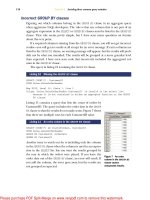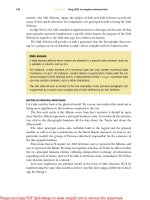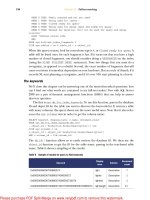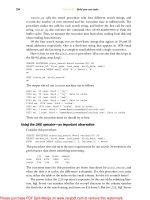SQL Server MVP Deep Dives- P4
Bạn đang xem bản rút gọn của tài liệu. Xem và tải ngay bản đầy đủ của tài liệu tại đây (804.57 KB, 40 trang )
76
CHAPTER 6
Error handling in SQL Server and applications
The ERROR_STATE() function can be used to determine the error state. Some system error messages can be raised at different points in the SQL Server engine. SQL
Server uses the error state to differentiate when these errors are raised.
The last two properties of an error are the line number and the name of the stored
procedure where the error occurred. These can be returned using the ERROR_LINE()
function and the ERROR_PROCEDURE() function, respectively. The ERROR_PROCEDURE()
function will return NULL if the error occurs outside a stored procedure. Listing 4 is an
example of these last two functions inside a stored procedure.
Listing 4
ERROR_LINE and ERROR_PROCEDURE functions in a stored procedure
CREATE PROCEDURE ChildError
AS
BEGIN
RAISERROR('My Error', 11, 1)
END
GO
CREATE PROCEDURE ParentError
AS
BEGIN
EXEC ChildError
END
GO
BEGIN TRY
EXEC ParentError
END TRY
BEGIN CATCH
SELECT Error_Line = ERROR_LINE(),
Error_Proc = ERROR_PROCEDURE()
END CATCH
This returns the following result:
Error_Line Error_Proc
----------- ------------4
ChildError
Let’s look now at how we can generate our own custom error messages.
Generate your own errors using RAISERROR
The RAISERROR function can be used to generate SQL Server errors and initiate any
error processing. The basic use of RAISERROR for a dynamic error looks like this:
RAISERROR('Invalid Customer', 11, 1)
This returns the following when run in SQL Server Management Studio:
Msg 50000, Level 11, State 1, Line 1
Invalid Customer
The first parameter is the custom error message. The second is the severity (or level).
Remember that 11 is the minimum severity that will cause a CATCH block to fire. The
last parameter is the error state.
Please purchase PDF Split-Merge on www.verypdf.com to remove this watermark.
Licensed to Kerri Ross <>
Handling errors inside SQL Server
77
RAISERROR can also be used to return user-created error messages. The code in listing 5 illustrates this.
Listing 5
Returning user-created error messages with RAISERROR
EXEC sp_addmessage
@msgnum = 50001,
@severity = 11,
@msgtext = 'My custom error',
@replace = 'replace';
GO
RAISERROR(50001, 11, 1);
GO
This returns the following result:
Msg 50001, Level 11, State 1, Line 1
My custom error
The @REPLACE parameter of sp_addmessage says to replace the error if it already
exists. When RAISERROR is called with a message description rather than an error number, it returns an error number 50000.
Ordinary users can specify RAISERROR with severity levels up to 18. To specify severity levels greater than 18, you must be in the sysadmin fixed server role or have been
granted ALTER TRACE permissions. You must also use the WITH LOG option. This
option logs the messages to the SQL Server log and the Windows Application Event
Log. WITH LOG may be used with any severity level. Using a severity level of 20 or
higher in a RAISERROR statement will cause the connection to close.
Nesting TRY...CATCH blocks
TRY...CATCH blocks can be nested inside either TRY or CATCH blocks. Nesting inside a
TRY block looks like listing 6.
Listing 6
Nesting TRY...CATCH blocks
BEGIN TRY
PRINT 'One'
BEGIN TRY
PRINT 1/0
END TRY
BEGIN CATCH
PRINT 'Caught by the inner catch'
END CATCH
PRINT 'Two'
END TRY
BEGIN CATCH
PRINT 'Caught by the outer catch'
END CATCH
Please purchase PDF Split-Merge on www.verypdf.com to remove this watermark.
Licensed to Kerri Ross <>
78
CHAPTER 6
Error handling in SQL Server and applications
This batch returns the following result:
One
Caught by the inner catch
Two
This allows specific statements inside a larger TRY...CATCH to have their own error
handling. A construct like this can be used to selectively handle certain errors and
pass any other errors further up the chain. Here’s an example in listing 7.
Listing 7
Error handling with nested TRY...CATCH statements
BEGIN TRY
PRINT 'One'
BEGIN TRY
PRINT CAST('Hello' AS DATETIME)
END TRY
BEGIN CATCH
IF ERROR_NUMBER() = 8134
PRINT 'Divide by zero. Again.'
ELSE
BEGIN
DECLARE @ErrorNumber INT;
DECLARE @ErrorMessage NVARCHAR(4000)
DECLARE @ErrorSeverity INT;
DECLARE @ErrorState INT;
SELECT
@ErrorNumber = ERROR_NUMBER(),
@ErrorMessage = ERROR_MESSAGE() + ' (%d)',
@ErrorSeverity = ERROR_SEVERITY(),
@ErrorState = ERROR_STATE();
RAISERROR( @ErrorMessage,
@ErrorSeverity,
@ErrorState,
@ErrorNumber )
END
END CATCH
PRINT 'Two'
END TRY
BEGIN CATCH
PRINT 'Error: ' + ERROR_MESSAGE()
END CATCH
This returns the following result:
One
Error: Conversion failed when converting datetime from character string.
(241)
In the inner CATCH block I’m checking whether we generated error number 8134
(divide by zero) and if so, I print a message. For every other error message, I “reraise”
or “rethrow” the error to the outer catch block. Note the text string that’s added to
Please purchase PDF Split-Merge on www.verypdf.com to remove this watermark.
Licensed to Kerri Ross <>
Handling errors inside SQL Server
79
the error message variable. The %d is a placeholder that’s replaced by the first additional parameter passed to RAISERROR, which is @ErrorNumber in my example. Books
Online has more information on the different types of replace variables that can be
used in RAISERROR.
The error functions can be used in any stored procedure called from inside the
CATCH block. This allows you to create standardized error-handling modules such as
the one in listing 8.
Listing 8
An error-handling module
CREATE PROCEDURE ErrorHandler
AS
BEGIN
PRINT 'I should log this error:'
PRINT ERROR_MESSAGE()
END
GO
BEGIN TRY
SELECT 1/0
END TRY
BEGIN CATCH
EXEC ErrorHandler
END CATCH
This block of code will return the following results:
I should log this error:
Divide by zero error encountered.
This is typically used to handle any errors in the code that logs the error information
to a custom error table.
TRY...CATCH and transactions
A common use for a TRY...CATCH block is to handle transaction processing. A common pattern for this is shown in listing 9.
Listing 9
Transaction processing in a TRY...CATCH block
BEGIN TRY
BEGIN TRANSACTION
INSERT INTO dbo.invoice_header
(invoice_number, client_number)
VALUES (2367, 19)
INSERT INTO dbo.invoice_detail
(invoice_number, line_number, part_number)
VALUES (2367, 1, 84367)
COMMIT TRANSACTION
END TRY
BEGIN CATCH
Please purchase PDF Split-Merge on www.verypdf.com to remove this watermark.
Licensed to Kerri Ross <>
80
CHAPTER 6
Error handling in SQL Server and applications
IF @@TRANCOUNT > 0 ROLLBACK TRANSACTION
-- And rethrow the error
END CATCH
Remember that the CATCH block completely consumes the error; therefore it is important to return some type of error or message back to the calling program.
Handling SQL Server errors on the client
The examples in this section use C# as the client application. Any .NET client application that supports try...catch constructs will behave in a similar fashion. The key
points to learn here are which .NET classes are involved in error handling and what
methods and properties they expose.
When a .NET application executes a SQL statement that causes an error, it throws a
SqlException. This can be caught using a try...catch block like we saw previously.
The SQL Server exception could also be caught by catching a plain Exception, but the
SqlException class provides additional SQL Server–specific properties. A simple
example of this in C# is shown in listing 10.
Listing 10
Outputting SQL Server–specific error properties with SqlException
using System.Data;
using System.Data.SqlClient;
class Program
{
SqlConnection conn = new SqlConnection("...");
SqlCommand cmd = new SqlCommand("RAISERROR('My Error', 11, 1)", conn);
try
{
cmd.Connection.Open();
cmd.ExecuteNonQuery();
Console.WriteLine("No error returned");
}
catch (SqlException sqlex)
{
Console.WriteLine("Error Message: " + sqlex.Message);
Console.WriteLine("Error Severity: {0}", sqlex.Class.ToString());
Console.WriteLine("Line Number: {0}", sqlex.LineNumber.ToString());
}
}
This returns the following result:
Error Message: My Error
Error Severity: 11
Line Number: 1
Exceptions with a severity of 10 or less don’t trigger the catch block on the client. The
connection is closed if the severity level is 20 or higher; it normally remains open if
the severity level is 19 or less. You can use RAISERROR to generate severities of 20 or
higher and it’ll close the connection and fire the try...catch block on the client.
Please purchase PDF Split-Merge on www.verypdf.com to remove this watermark.
Licensed to Kerri Ross <>
Handling SQL Server errors on the client
81
The error returned typically indicates that the connection was closed rather than the
error text you specified.
The SqlException class inherits from the System.SystemException and includes
many properties that are specific to .NET. Some key SQL Server–specific properties of
the SqlException class are shown in table 1.
Table 1
SQLException class properties
Property
Description
Class
Error severity level
LineNumber
Line number in the batch or stored procedure where the error occurred
Message
Description of the error
Number
SQL Server error number
Procedure
Stored procedure name where the error occurred
Server
SQL Server instance that generated the error
Source
Provider that generated the error (for example, .Net SqlClient Data Provider)
State
SQL Server error state (the third parameter of RAISERROR)
Another interesting property of the SqlException class is the Errors property. This is
a collection of SqlError objects. The SqlError class includes only the SQL Server–
specific properties from the SqlException object that are listed in table 1. Because a
batch of SQL can generate multiple SQL Server errors, an application needs to check
whether multiple errors have occurred. The first error in the Errors property will
always match the error in the SqlExcpetion’s properties. Listing 11 is an example.
Listing 11
Handling multiple errors with the Errors property
using System.Data;
using System.Data.SqlClient;
class Program
{
static void Main(string[] args)
{
SqlConnection conn = new SqlConnection(@"Server=L60\YUKON;
➥Integrated Security=SSPI");
SqlCommand cmd = new SqlCommand(
@"RAISERROR('My Error', 11, 17)
SELECT 1/0
SELECT * FROM dbo.BadTable", conn);
try
{
cmd.Connection.Open();
cmd.ExecuteReader();
Please purchase PDF Split-Merge on www.verypdf.com to remove this watermark.
Licensed to Kerri Ross <>
82
CHAPTER 6
Error handling in SQL Server and applications
Console.WriteLine("No error returned");
}
catch (SqlException sqlex)
{
for (int i = 0; i < sqlex.Errors.Count; i++)
{
Console.WriteLine("Error #{0}: {1}",
i.ToString(), sqlex.Errors[i].Message);
}
}
}
}
This returns the following result:
Error #0: My Error
Error #1: Divide by zero error encountered.
Error #2: Invalid object name 'dbo.BadTable'.
In closing, let’s look at how we can handle SQL Server messages inside our application
code.
Handling SQL Server messages on the client
When a message is sent from SQL Server via a PRINT statement or a RAISERROR with a
severity level of 10 or less, it generates an event on the .NET side. You can capture this
event by writing a handler for the SqlConnection class’s InfoMessage event. The handler for the InfoMessage event takes two parameters: the sender and an instance of
SqlInfoMessageEventArgs. This class contains three properties. The first is the Message that was printed or generated by the RAISERROR statement. The second is the
Source, which is usually the .Net SqlClient Data Provider. The third is the Errors
property, which is a collection of SqlError objects and behaves just like it did when
we saw it earlier. Listing 12 is an example.
Listing 12
Outputting SQL Server messages
using System.Data;
using System.Data.SqlClient;
class Program
{
static void Main(string[] args)
{
SqlConnection conn = new SqlConnection(@"Server=L60\YUKON;
➥Integrated Security=SSPI");
SqlCommand cmd = new SqlCommand("PRINT 'Hello'", conn);
conn.InfoMessage += new
➥SqlInfoMessageEventHandler(conn_InfoMessage);
try
{
cmd.Connection.Open();
Please purchase PDF Split-Merge on www.verypdf.com to remove this watermark.
Licensed to Kerri Ross <>
Handling SQL Server errors on the client
83
cmd.ExecuteNonQuery();
cmd.CommandText ="RAISERROR('An error as message', 5, 12)";
cmd.ExecuteNonQuery();
Console.WriteLine("No error returned");
}
catch (SqlException sqlex)
{
Console.WriteLine("First Error Message: " + sqlex.Message);
Console.WriteLine("Error Count: {0}",
➥sqlex.Errors.Count.ToString());
}
}
static void conn_InfoMessage(object sender, SqlInfoMessageEventArgs e)
{
Console.WriteLine("SQL Server Message: {0}", e.Message);
Console.WriteLine("Message Source: {0}", e.Source);
Console.WriteLine("Message Count: {0}", e.Errors.Count.ToString());
}
}
This returns the following result:
SQL Server Message: Hello
Message Source: .Net SqlClient Data Provider
Message Count: 1
SQL Server Message: An error as message
Message Source: .Net SqlClient Data Provider
Message Count: 1
No error returned
Another interesting characteristic of this approach is that you can capture informational RAISERROR statements as they’re executed rather than when a batch ends. Listing 13 shows an example.
Listing 13
Capturing RAISERROR statements
using System.Data;
using System.Data.SqlClient;
class Program
{
static void Main(string[] args)
{
SqlConnection conn = new SqlConnection(@"Server=L60\YUKON;
➥Integrated Security=SSPI");
SqlCommand cmd = new SqlCommand(
@"PRINT 'Printed at buffer flush'
RAISERROR('Starting', 0, 1) WITH NOWAIT;
WAITFOR DELAY '00:00:03';
RAISERROR('Status', 0, 1) WITH NOWAIT;
WAITFOR DELAY '00:00:03';
PRINT 'Done';", conn);
conn.InfoMessage += new
➥SqlInfoMessageEventHandler(conn_ShortMessage);
Please purchase PDF Split-Merge on www.verypdf.com to remove this watermark.
Licensed to Kerri Ross <>
84
CHAPTER 6
Error handling in SQL Server and applications
try
{
cmd.Connection.Open();
cmd.ExecuteReader();
Console.WriteLine("No error returned");
}
catch (SqlException sqlex)
{
Console.WriteLine("First Error Message: " + sqlex.Message);
Console.WriteLine("Error Count: {0}",
➥sqlex.Errors.Count.ToString());
}
}
static void conn_ShortMessage(object sender, SqlInfoMessageEventArgs e)
{
Console.WriteLine("[{0}] SQL Server Message: {1}",
System.DateTime.Now.ToLongTimeString(), e.Message);
}
}
This returns the following result:
[3:39:26
[3:39:26
[3:39:29
[3:39:32
No error
PM] SQL Server
PM] SQL Server
PM] SQL Server
PM] SQL Server
returned
Message:
Message:
Message:
Message:
Printed at buffer flush
Starting
Status
Done
Normally, when you do a series of PRINT statements inside a SQL Server batch or
stored procedure, the results are all returned at the end. A RAISERROR WITH NOWAIT is
sent immediately to the client, as is any previous PRINT statement. If you remove the
WITH NOWAIT from the first RAISERROR, the first three lines are all printed at the same
time when the RAISERROR WITH NOWAIT pushes them all to the client. This approach
can provide a convenient way to return status information for long-running tasks that
contain multiple SQL statements.
Summary
SQL Server error handling doesn’t need to be an afterthought. SQL Server 2005 pro-
vides powerful tools that allow developers to selectively handle, capture, and consume
errors inside SQL Server. Errors that can’t be handled on the server can be passed
back to the application. .NET has specialized classes that allow applications to capture
detailed information about SQL Server exceptions.
Please purchase PDF Split-Merge on www.verypdf.com to remove this watermark.
Licensed to Kerri Ross <>
Summary
85
About the author
Bill Graziano has been a SQL Server consultant for 10 years,
doing production support, performance tuning, and application development. He serves on the board of directors for the
Professional Association for SQL Server (PASS), where he
serves as the vice president of marketing and sits on the executive committee. He’s a regular speaker at conferences and
user groups across the country. Bill runs the popular web site
http:/
/SQLTeam.com and is currently a SQL Server MVP.
Please purchase PDF Split-Merge on www.verypdf.com to remove this watermark.
Licensed to Kerri Ross <>
7 Pulling apart the FROM clause
Rob Farley
When can you ever have a serious query that doesn’t involve more than one table?
Normalization is a wonderful thing and helps ensure that our databases have
important characteristics such as integrity. But it also means using JOINs, because
it’s unlikely that all the data we need to solve our problem occurs in a single table.
Almost always, our FROM clause contains several tables.
In this chapter, I’ll explain some of the deeper, less understood aspects of the
FROM clause. I’ll start with some of the basics, to make sure we’re all on the same
page. You’re welcome to skip ahead if you’re familiar with the finer points of INNER,
OUTER, and CROSS. I’m often amazed by the fact that developers the world over
understand how to write a multi-table query, and yet few understand what they’re
asking with such a query.
JOIN basics
Without JOINs, our FROM clause is incredibly simple. Assuming that we’re using only
tables (rather than other constructs such as subqueries or functions), JOINs are one
of the few ways that we can make our query more complicated. JOINs are part of
day one in most database courses, and every day that follows is full of them. They
are the simplest mechanism to allow access to data within other tables. We'll cover
the three types of JOINs in the sections that follow.
The INNER JOIN
The most common style of JOIN is the INNER JOIN. I’m writing that in capitals
because it’s the keyword expression used to indicate the type of JOIN being used,
but the word INNER is completely optional. It’s so much the most common style of
JOIN that when we write only JOIN, we’re referring to an INNER JOIN.
An INNER JOIN looks at the two tables involved in the JOIN and identifies matching rows according to the criteria in the ON clause. Every INNER JOIN requires an ON
clause—it’s not optional. Aliases are optional, and can make the ON clause much
86
Please purchase PDF Split-Merge on www.verypdf.com to remove this watermark.
Licensed to Kerri Ross <>
JOIN basics
87
shorter and simpler to read (and the rest of the query too). I’ve made my life easier by
specifying p and s after the table names in the query shown below (to indicate Product and ProductSubcategory respectively). In this particular example, the match condition is that the value in one column in the first table must be the same as the
column in the second table. It so happens that the columns have the same name;
therefore, to distinguish between them, I've specified one to be from the table p, and
the other from the table s. It wouldn’t have mattered if I specified these two columns
in the other order—equality operations are generally commutative, and it doesn’t
matter whether I write a=b or b=a.
The query in listing 1 returns a set of rows from the two tables, containing all the
rows that have matching values in their ProductSubcategoryID columns. This query,
as with most of the queries in this chapter, will run on the AdventureWorks database,
which is available as a sample database for SQL Server 2005 or SQL Server 2008.
Listing 1
Query to return rows with matching product subcategories
SELECT p.Name, s.Name
FROM Production.Product p
JOIN
Production.ProductSubcategory s
ON p.ProductSubcategoryID = s.ProductSubcategoryID;
This query could return more rows than there are in the Product table, fewer rows, or
the same number of rows. We’ll look at this phenomenon later in the chapter, as well
as what can affect this number.
The OUTER JOIN
An OUTER JOIN is like an INNER JOIN except that rows that do not have matching values
in the other table are not excluded from the result set. Instead, the rows appear with
NULL entries in place of the columns from the other table. Remembering that a JOIN is
always performed between two tables, these are the variations of OUTER JOIN:
LEFT—Keeps all rows from the first table (inserting NULLs for the second table’s
columns)
RIGHT—Keeps all rows from the second table (inserting NULLs for the first
table’s columns)
FULL—Keeps all rows from both tables (inserting NULLs on the left or the right,
as appropriate)
Because we must specify whether the OUTER JOIN is LEFT, RIGHT, or FULL, note that the
keyword OUTER is optional—inferred by the fact that we have specified its variation. As
in listing 2, I generally omit it, but you’re welcome to use it if you like.
Please purchase PDF Split-Merge on www.verypdf.com to remove this watermark.
Licensed to Kerri Ross <>
88
CHAPTER 7
Listing 2
Pulling apart the FROM clause
A LEFT OUTER JOIN
SELECT p.Name, s.Name
FROM Production.Product p
LEFT JOIN
Production.ProductSubcategory s
ON p.ProductSubcategoryID = s.ProductSubcategoryID;
The query in listing 2 produces results similar to the results of the last query, except
that products that are not assigned to a subcategory are still included. They have NULL
listed for the second column. The smallest number of rows that could be returned by
this query is the number of rows in the Product table, as none can be eliminated.
Had we used a RIGHT JOIN, subcategories that contained no products would have
been included. Take care when dealing with OUTER JOINs, because counting the rows
for each subcategory would return 1 for an empty subcategory, rather than 0. If you
intend to count the products in each subcategory, it would be better to count the
occurrences of a non-NULL ProductID or Name instead of using COUNT(*). The queries in listing 3 demonstrate this potential issue.
Listing 3
Beware of COUNT(*) with OUTER JOINs
/* First ensure there is a subcategory with no corresponding products */
INSERT Production.ProductSubcategory (Name) VALUES ('Empty Subcategory');
SELECT s.Name, COUNT(*) AS NumRows
FROM Production.ProductSubcategory s
LEFT JOIN
Production.Product p
ON s.ProductSubcategoryID = p.ProductSubcategoryID
GROUP BY s.Name;
SELECT s.Name, COUNT(p.ProductID) AS NumProducts
FROM Production.ProductSubcategory s
LEFT JOIN
Production.Product p
ON s.ProductSubcategoryID = p.ProductSubcategoryID
GROUP BY s.Name;
Although LEFT and RIGHT JOINs can be made equivalent by listing the tables in the
opposite order, FULL is slightly different, and will return at least as many rows as the
largest table (as no rows can be eliminated from either side).
The CROSS JOIN
A CROSS JOIN returns every possible combination of rows from the two tables. It’s like
an INNER JOIN with an ON clause that evaluates to true for every possible combination
of rows. The CROSS JOIN doesn’t use an ON clause at all. This type of JOIN is relatively
rare, but it can effectively solve some problems, such as for a report that must include
every combination of SalesPerson and SalesTerritory (showing zero or NULL where
appropriate). The query in listing 4 demonstrates this by first performing a CROSS
JOIN, and then a LEFT JOIN to find sales that match the criteria.
Please purchase PDF Split-Merge on www.verypdf.com to remove this watermark.
Licensed to Kerri Ross <>
Formatting your FROM clause
Listing 4
89
Using a CROSS JOIN to cover all combinations
SELECT p.SalesPersonID, t.TerritoryID, SUM(s.TotalDue) AS TotalSales
FROM Sales.SalesPerson p
CROSS JOIN
Sales.SalesTerritory t
LEFT JOIN
Sales.SalesOrderHeader s
ON p.SalesPersonID = s.SalesPersonID
AND t.TerritoryID = s.TerritoryID
GROUP BY p.SalesPersonID, t.TerritoryID;
Formatting your FROM clause
I recently heard someone say that formatting shouldn’t be a measure of good or bad
practice when coding. He was talking about writing C# code and was largely taking
exception to being told where to place braces. I’m inclined to agree with him to a certain extent. I do think that formatting guidelines should form a part of company
coding standards so that people aren’t put off by the layout of code written by a colleague, but I think the most important thing is consistency, and Best Practices guides
that you find around the internet should generally stay away from formatting. When it
comes to the FROM clause, though, I think formatting can be important.
A sample query
The Microsoft Project Server Report Pack is a valuable resource for people who use
Microsoft Project Server. One of the reports in the pack is a Timesheet Audit Report,
which you can find at I
sometimes use this when teaching T-SQL.
The main query for this report has a FROM clause which is hard to understand. I’ve
included it in listing 5, keeping the formatting exactly as it is on the website. In the following sections, we’ll demystify it by using a method for reading FROM clauses, and
consider ways that this query could have retained the same functionality without being
so confusing.
Listing 5
FROM
A FROM clause from the Timesheet Audit Report
MSP_EpmResource
LEFT OUTER JOIN MSP_TimesheetResource
INNER JOIN MSP_TimesheetActual
ON MSP_TimesheetResource.ResourceNameUID
= MSP_TimesheetActual.LastChangedResourceNameUID
ON MSP_EpmResource.ResourceUID
= MSP_TimesheetResource.ResourceUID
LEFT OUTER JOIN MSP_TimesheetPeriod
INNER JOIN MSP_Timesheet
ON MSP_TimesheetPeriod.PeriodUID
= MSP_Timesheet.PeriodUID
Please purchase PDF Split-Merge on www.verypdf.com to remove this watermark.
Licensed to Kerri Ross <>
90
CHAPTER 7
Pulling apart the FROM clause
INNER JOIN MSP_TimesheetPeriodStatus
ON MSP_TimesheetPeriod.PeriodStatusID
= MSP_TimesheetPeriodStatus.PeriodStatusID
INNER JOIN MSP_TimesheetStatus
ON MSP_Timesheet.TimesheetStatusID
= MSP_TimesheetStatus.TimesheetStatusID
ON MSP_TimesheetResource.ResourceNameUID
= MSP_Timesheet.OwnerResourceNameUID
The appearance of most queries
In the western world, our languages tend to read from left to right. Because of this,
people tend to approach their FROM clauses from left to right as well.
For example, they start with one table:
FROM
MSP_EpmResource
Then they JOIN to another table:
FROM
MSP_EpmResource
LEFT OUTER JOIN MSP_TimesheetResource
ON MSP_EpmResource.ResourceUID
= MSP_TimesheetResource.ResourceUID
And they keep repeating the pattern:
FROM
MSP_EpmResource
LEFT OUTER JOIN MSP_TimesheetResource
ON MSP_EpmResource.ResourceUID
= MSP_TimesheetResource.ResourceUID
INNER JOIN MSP_TimesheetActual
ON MSP_TimesheetResource.ResourceNameUID
= MSP_TimesheetActual.LastChangedResourceNameUID
They continue by adding on the construct JOIN table_X ON table_X.col = table_
Y.col.
Effectively, everything is done from the perspective of the first table in the FROM
clause. Some of the JOINs may be OUTER JOINs, some may be INNER, but the principle
remains the same—that each table is brought into the mix by itself.
When the pattern doesn’t apply
In our sample query, this pattern doesn’t apply. We start with two JOINs, followed by
two ONs. That doesn’t fit the way we like to think of our FROM clauses. If we try to rearrange the FROM clause to fit, we find that we can’t. But that doesn’t stop me from trying to get my students to try; it’s good for them to appreciate that not all queries can
be written as they prefer. I get them to start with the first section (before the second
LEFT JOIN):
FROM
MSP_EpmResource
LEFT OUTER JOIN MSP_TimesheetResource
INNER JOIN MSP_TimesheetActual
Please purchase PDF Split-Merge on www.verypdf.com to remove this watermark.
Licensed to Kerri Ross <>
Formatting your FROM clause
91
ON MSP_TimesheetResource.ResourceNameUID
= MSP_TimesheetActual.LastChangedResourceNameUID
ON MSP_EpmResource.ResourceUID
= MSP_TimesheetResource.ResourceUID
Many of my students look at this part and immediately pull the second ON clause
(between MSP_EpmResource and MSP_TimesheetResource) and move it to before
the INNER JOIN. But because we have an INNER JOIN applying to MSP_TimesheetResource, this would remove any NULLs that are the result of the OUTER JOIN. Clearly
the logic has changed. Some try to fix this by making the INNER JOIN into a LEFT JOIN,
but this changes the logic as well. Some move the tables around, listing
MSP_EpmResource last, but the problem always comes down to the fact that people
don’t understand this query. This part of the FROM clause can be fixed by using a RIGHT
JOIN, but even this has problems, as you may find if you try to continue the pattern
with the other four tables in the FROM clause.
How to read a FROM clause
A FROM clause is easy to read, but you have to understand the method. When I ask my
students what the first JOIN is, they almost all say “the LEFT JOIN,” but they’re wrong.
The first JOIN is the INNER JOIN, and this is easy to find because it’s the JOIN that
matches the first ON. To find the first JOIN, you have to find the first ON. Having found
it, you work backwards to find its JOIN (which is the JOIN that immediately precedes
the ON, skipping past any JOINs that have already been allocated to an ON clause). The
right side of the JOIN is anything that comes between an ON and its corresponding
JOIN. To find the left side, you keep going backwards until you find an unmatched
JOIN or the FROM keyword. You read a FROM clause that you can’t immediately understand this way:
1
2
3
4
5
Find the first (or next) ON keyword.
Work backwards from the ON, looking for an unmatched JOIN.
Everything between the ON and the JOIN is the right side.
Keep going backwards from the JOIN to find the left side.
Repeat until all the ONs have been found.
Using this method, we can clearly see that the first JOIN in our sample query is the
INNER JOIN, between MSP_TimesheetResource and MSP_TimesheetActual. This forms
the right side of the LEFT OUTER JOIN, with MSP_EpmResource being the left side.
When the pattern can’t apply
Unfortunately for our pattern, the next JOIN is the INNER JOIN between MSP_
TimesheetPeriod and MSP_Timesheet. It doesn’t involve any of the tables we’ve
already brought into our query. When we continue reading our FROM clause, we eventually see that the query involves two LEFT JOINs, for which the right sides are a series
of nested INNER JOINs. This provides logic to make sure that the NULLs are introduced
only to the combination of MSP_TimesheetResource and MSP_TimesheetActual, not
Please purchase PDF Split-Merge on www.verypdf.com to remove this watermark.
Licensed to Kerri Ross <>
92
CHAPTER 7
Pulling apart the FROM clause
just one of them individually, and similarly for the combination of MSP_TimesheetPeriod through MSP_TimesheetStatus.
And this is where the formatting becomes important. The layout of the query in its
initial form (the form in which it appears on the website) doesn’t suggest that anything is nested. I would much rather have seen the query laid out as in listing 6. The
only thing I have changed about the query is the whitespace and aliases, and yet you
can see that it’s far easier to read.
Listing 6
A reformatted version of the FROM clause in listing 5
FROM
MSP_EpmResource r
LEFT OUTER JOIN
MSP_TimesheetResource tr
INNER JOIN
MSP_TimesheetActual ta
ON tr.ResourceNameUID = ta.LastChangedResourceNameUID
ON r.ResourceUID = tr.ResourceUID
LEFT OUTER JOIN
MSP_TimesheetPeriod tp
INNER JOIN
MSP_Timesheet t
ON tp.PeriodUID = t.PeriodUID
INNER JOIN
MSP_TimesheetPeriodStatus tps
ON tp.PeriodStatusID = tps.PeriodStatusID
INNER JOIN
MSP_TimesheetStatus ts
ON t.TimesheetStatusID = ts.TimesheetStatusID
ON tr.ResourceNameUID = t.OwnerResourceNameUID
Laying out the query like this doesn’t change the importance of knowing how to read
a query when you follow the steps I described earlier, but it helps the less experienced
people who need to read the queries you write. Bracketing the nested sections may
help make the query even clearer, but I find that bracketing can sometimes make people confuse these nested JOINs with derived tables.
Writing the FROM clause clearly the first time
In explaining the Timesheet Audit Report query, I’m not suggesting that it’s wise to
nest JOINs as I just described. However, being able to read and understand a complex
FROM clause is a useful skill that all query writers should have. They should also write
queries that less skilled readers can easily understand.
Filtering with the ON clause
When dealing with INNER JOINs, people rarely have a problem thinking of the ON
clause as a filter. Perhaps this comes from earlier days of databases, when we listed
tables using comma notation and then put the ON clause predicates in the WHERE
clause. From this link with the WHERE clause, we can draw parallels between the ON and
Please purchase PDF Split-Merge on www.verypdf.com to remove this watermark.
Licensed to Kerri Ross <>
Filtering with the ON clause
93
WHERE clauses, but the ON clause is a different kind of filter, as I’ll demonstrate in the
following sections.
The different filters of the SELECT statement
The most obvious filter in a SELECT statement is the WHERE clause. It filters out the
rows that the FROM clause has produced. The database engine controls entirely the
order in which the various aspects of a SELECT statement are applied, but logically the
WHERE clause is applied after the FROM clause has been completed.
People also understand that the HAVING clause is a filter, but they believe mistakenly that the HAVING clause is used when the filter must involve an aggregate function.
In actuality (but still only logically), the HAVING clause is applied to the groups that
have been formed through the introduction of aggregates or a GROUP BY clause. It
could therefore be suggested that the ON clause isn’t a filter, but rather a mechanism
to describe the JOIN context. But it is a filter.
Filtering out the matches
Whereas the WHERE clause filters out rows, and the HAVING clause filters out groups, the
ON clause filters out matches.
In an INNER JOIN, only the matches persist into the final results. Given all possible
combinations of rows, only those that have successful matches are kept. Filtering out
a match is the same as filtering out a row. For OUTER JOINs, we keep all the matches
and then introduce NULLs to avoid eliminating rows that would have otherwise been
filtered out. Now the concept of filtering out a match differs a little from filtering out
a row.
When a predicate in the ON clause involves columns from both sides of the JOIN, it
feels quite natural to be filtering matches this way. We can even justify the behavior of
an OUTER JOIN by arguing that OUTER means that we’re putting rows back in after
they’ve been filtered out. But when we have a predicate that involves only one side of
the JOIN, things feel a bit different.
Now the success of the match has a different kind of dependency on one side than
on the other. Suppose a LEFT JOIN has an ON clause like the one in listing 7.
Listing 7
Placing a predicate in the ON clause of an outer join
SELECT p.SalesPersonID, o.SalesOrderID, o.OrderDate
FROM
Sales.SalesPerson p
LEFT JOIN
Sales.SalesOrderHeader o
ON o.SalesPersonID = p.SalesPersonID
AND o.OrderDate < '20020101';
For an INNER JOIN, this would be simple, and we’d probably have put the OrderDate
predicate in the WHERE clause. But for an OUTER JOIN, this is different.
Please purchase PDF Split-Merge on www.verypdf.com to remove this watermark.
Licensed to Kerri Ross <>
94
CHAPTER 7
Pulling apart the FROM clause
Often when we write an OUTER JOIN, we start with an INNER JOIN and then change
the keyword to use LEFT instead of INNER (in fact, we probably leave out the word
INNER). Making an OUTER JOIN from an INNER JOIN is done so that, for example, the
salespeople who haven’t made sales don’t get filtered out. If that OrderDate predicate
was in the WHERE clause, merely changing INNER JOIN to LEFT JOIN wouldn’t have
done the job.
Consider the case of AdventureWorks’ SalesPerson 290, whose first sale was in
2003. A LEFT JOIN without the OrderDate predicate would include this salesperson,
but then all the rows for that salesperson would be filtered out by the WHERE clause.
This wouldn’t be correct if we were intending to keep all the salespeople.
Consider also the case of a salesperson with no sales. That person would be
included in the results of the FROM clause (with NULL for the Sales.SalesOrderHeader
columns), but then would also be filtered out by the WHERE clause.
The answer is to use ON clause predicates to define what constitutes a valid match,
as we have in our code segment above. This means that the filtering is done before the
NULLs are inserted for salespeople without matches, and our result is correct. I understand that it may seem strange to have a predicate in an ON clause that involves only
one side of the JOIN, but when you understand what’s being filtered (rows with WHERE,
groups with HAVING, and matches with ON), it should feel comfortable.
JOIN uses and simplification
To understand the FROM clause, it’s worth appreciating the power of the query optimizer. In this final part of the chapter, we'll examine four uses of JOINs. We’ll then see
how your query can be impacted if all these uses are made redundant.
The four uses of JOINs
Suppose a query involves a single table. For our example, we'll use Production.Product from the AdventureWorks sample database. Let’s imagine that this table is joined
to another table, say Production.ProductSubcategory. A foreign key relationship is
defined between the two tables, and our ON clause refers to the ProductSubcategoryID
column in each table. Listing 8 shows a view that reflects this query.
Listing 8
View to return products and their subcategories
CREATE VIEW dbo.ProductsPlus AS
SELECT p.*, s.Name as SubcatName
FROM
Production.Product p
JOIN
Production.ProductSubcategory s
ON p.ProductSubcategoryID = s.ProductSubcategoryID;
This simple view provides us with the columns of the Product table, with the name of
the ProductSubcategory to which each product belongs. The query used is a standard
lookup query, one that query writers often create.
Please purchase PDF Split-Merge on www.verypdf.com to remove this watermark.
Licensed to Kerri Ross <>
The four uses of JOINs
95
Comparing the contents of this view to the Product table alone (I say contents
loosely, as a view doesn’t store data unless it is an indexed view; it is simply a stored
subquery), there are two obvious differences.
First, we see that we have an extra column. We could have made our view contain
as many of the columns from the second table as we like, but for now I’m using only
one. This is the first of the four uses. It seems a little trivial, but nevertheless, we have
use #1: additional columns.
Secondly, we have fewer rows in the view than in the Product table. A little investigation shows that the ProductSubcategoryID column in Production.Product allows
NULL values, with no matching row in the Production.ProductSubcategory table. As
we’re using an INNER JOIN, these rows without matches are eliminated from our
results. This could have been our intention, and therefore we have use #2: eliminated rows.
We can counteract this side effect quite easily. To avoid rows from Production.
Product being eliminated, we need to convert our INNER JOIN to an OUTER JOIN. I have
made this change and encapsulated it in a second view in listing 9, named
dbo.ProductsPlus2 to avoid confusion.
Listing 9
View to return all products and their subcategories (if they exist)
CREATE VIEW dbo.ProductsPlus2 AS
SELECT p.*, s.Name AS SubcatName
FROM
Production.Product p
LEFT JOIN
Production.ProductSubcategory s
ON p.ProductSubcategoryID = s.ProductSubcategoryID;
Now when we query our view, we see that it gives us the same number of rows as in the
Production.Product table.
JOINs have two other uses that we don’t see in our view.
As this is a foreign-key relationship, the column in Production.ProductSubcategory
is the primary key, and therefore unique. There must be at most one matching row for
each row in Production.Product—thereby not duplicating any of the rows from Production.Product. If Production.ProductSubcategory.ProductSubcategoryID weren’t
unique, though, we could find ourselves using a JOIN for use #3: duplicated rows.
Please understand I am considering this only from the perspective of the first
table, and the lack of duplications here is completely expected and desired. If we consider the query from the perspective of the second table, we are indeed seeing the
duplication of rows. I am focusing on one table in order to demonstrate when the
JOIN serves no direct purpose.
The fourth use is more obscure. When an OUTER JOIN is performed, rows that
don’t have matches are persisted using NULL values for columns from the other table.
In our second view above, we are using a LEFT JOIN, and NULL appears instead of the
Name column from the Production.ProductSubcategory table. This has no effect on
Please purchase PDF Split-Merge on www.verypdf.com to remove this watermark.
Licensed to Kerri Ross <>
96
CHAPTER 7
Pulling apart the FROM clause
the fields from the table of products, but if we were using a RIGHT JOIN or FULL JOIN,
and we had subcategories that contained no products allocated, we would find additional rows amongst our list of Products. That’s use #4: added NULL rows.
These four uses make up the entire functionality and purpose of JOINs: (1)gaining
additional columns, (2)eliminating rows, (3)duplicating rows, and (4)adding NULL
rows. The most commonly desired function would be the first one listed, but the other
functions are just as valid. Perhaps we’re counting the number of times an event has
occurred, and we take advantage of the duplication effect. Perhaps we want to consider only those records that have a match in another table, or perhaps we are using
the added NULLs to find the empty subcategories. Whatever the business reason for performing the JOIN, everything comes back to these four uses.
Simplification using views
If listing the name of the ProductSubcategory with the product is often required, then
a lookup similar to the one in the views created earlier could be functionality that is
repeated frequently. Although a developer may consider this trivial and happily write
out this JOIN notation as often as needed, there may be a temptation to use a view to
simplify the query.
Consider the query in listing 10.
Listing 10
Query to return products and their subcategory
SELECT p.ProductID, p.Name, p.Color, s.Name as SubcatName
FROM
Production.Product p
LEFT JOIN
Production.ProductSubcategory s
ON p.ProductSubcategoryID = s.ProductSubcategoryID;
For every product in the Production.Product table, we are selecting the ProductID,
Name, and Color, with the name of the subcategory to which it belongs. From our earlier discussion, we can see that the JOIN is not eliminating or duplicating rows, nor
adding NULL rows, because of the LEFT JOIN, the uniqueness of s.ProductSubcategoryID, and the absence of a RIGHT/FULL JOIN, respectively.
Whereas it may seem useful to see that the SubcatName column is coming from a
different table, the query could seem much simpler if it took advantage of our view
dbo.ProductsPlus2, as created earlier:
SELECT ProductID, Name, Color, SubcatName
FROM dbo.ProductsPlus2;
Again, a view doesn’t store any data unless it is indexed. In its non-indexed form, a
view is just a stored subquery. You can compare the execution plans of these two queries, as shown in figure 1, to see that they are executed in exactly the same way.
The powerful aspect of this view occurs if we’re not interested in the SubcatName
column:
Please purchase PDF Split-Merge on www.verypdf.com to remove this watermark.
Licensed to Kerri Ross <>
Simplification using views
Figure 1
97
Identical query plans demonstrating the breakdown of the view
SELECT ProductID, Name, Color
FROM dbo.ProductsPlus2;
Look at the execution plan for this query, as shown in figure 2, and you'll see a vast difference from the previous one. Despite the fact that our view definition involves a second table, this table is not being accessed at all.
The reason for this is straightforward. The query optimizer examines the effects
that the JOIN might have. When it sees that none apply (the only one that had applied
was additional columns; ignoring the SubcatName column removes that one too), it
realizes that the JOIN is not being used and treats the query as if the JOIN were not
there at all. Furthermore, if we were not querying the Color column (as shown in figure 3), the query could take advantage of one of the nonclustered indexes on the
Product table, as if we were querying the table directly.
Please purchase PDF Split-Merge on www.verypdf.com to remove this watermark.
Licensed to Kerri Ross <>
98
CHAPTER 7
Pulling apart the FROM clause
Figure 2
A much simpler execution plan involving only one table
Figure 3
A nonclustered index being used
Please purchase PDF Split-Merge on www.verypdf.com to remove this watermark.
Licensed to Kerri Ross <>
Simplification using views
99
As an academic exercise, I’m going to introduce a third view in listing 11—one that
uses a FULL JOIN.
Listing 11
Using a FULL JOIN
CREATE VIEW dbo.ProductsPlus3 AS
SELECT p.*, s.Name as SubcatName
FROM
Production.Product p
FULL JOIN
Production.ProductSubcategory s
ON p.ProductSubcategoryID = s.ProductSubcategoryID;
This is far less useful, but I want to demonstrate the power of the query optimizer, so
that you can better appreciate it and design your queries accordingly. In figure 4,
notice the query plan that is being used when querying dbo.ProductsPlus3.
This time, when we query only the Name and ProductID fields, the query optimizer does not simplify out the Production.ProductSubcategory table. To find out
why, let’s look at the four JOIN uses. No additional columns are being used from that
table. The FULL JOIN prevents any elimination.No duplication is being created as the
ProductSubcategoryID field is still unique in the second table. But the other use of a
JOIN—the potential addition of NULL rows—could apply. In this particular case we
have no empty subcategories and no rows are added, but the system must still perform
the JOIN to satisfy this scenario.
Figure 4
The ProductSubcategory table being used again
Please purchase PDF Split-Merge on www.verypdf.com to remove this watermark.
Licensed to Kerri Ross <>
100
CHAPTER 7
Figure 5
Pulling apart the FROM clause
This execution plan is simpler because NULLs are not being introduced.
Another way to ensure that NULL rows do not appear in the results of a query would be
to use a WHERE clause:
SELECT ProductID, Name
FROM dbo.ProductsPlus3
WHERE NOT ProductID IS NULL;
And now once more our execution plan has been simplified into a single-table query
as shown in figure 5. The system detects that this particular use for a JOIN is made
redundant regardless of whether it is being negated within the view or within the
outer query. After all, we’ve already seen that the system treats a view as a subquery.
Regardless of what mechanism is stopping the JOIN from being used, the optimizer
will be able to remove it from the execution plan if it is redundant.
How JOIN uses affect you
Although this may all seem like an academic exercise, there are important takeaways.
If the optimizer can eliminate tables from your queries, then you may see significant performance improvement. Recently I spent some time with a client who had a
view that involved many tables, each with many columns. The view used OUTER JOINs,
but investigation showed that the underlying tables did not have unique constraints
on the columns involved in the JOINs. Changing this meant that the system could
eliminate many more tables from the queries, and performance increased by orders
of magnitude.
Please purchase PDF Split-Merge on www.verypdf.com to remove this watermark.
Licensed to Kerri Ross <>
